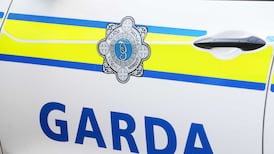It seems appropriate that an exhibition with home as a theme should be scheduled to open in early December, close to Christmas, when home is, traditionally, on our minds. The fact that the show is on at the Douglas Hyde Gallery, however, and that its selector and curator is the gallery director, John Hutchinson, suggests that we're not in for a feast of Dickensian sentimentality. And such is the case. Hutchinson is known for his refined, highly individual aesthetic sense. As regular visitors to the Douglas Hyde will know, for him less is definitely more. Exhibitions there are usually honed and concentrated, physically spare and intellectually demanding. He favours suggestion, understatement, obliqueness. Home for him, in this context, is not so much bricks and mortar as "an internal space". He has gathered together work by eight artists who, he suggests, explore aspects of what home in that deeper sense might be - what it might be for all of us.
It's immediately striking that the show is imbued with feelings of distance, melancholy, journeying, suggesting a sense of home as something longed for, remembered but perhaps irrevocably lost or unattainable. Is that a fair impression? It is, he agrees: "I suppose I was interested in that sense of remoteness and melancholy." He cites the way the numerous journeys described in the books of W .G. Sebald, including particularly The Emigrants, in the end lead as much, or more importantly, to inner states as outer destinations.
Jan Jedlicka's sequence of monochrome photographs, A Winter Journey to the Sea, are just that, an account of a journey by rail from Switzerland to the coast in the Netherlands, recorded on a single roll of film, of which every frame is printed and displayed. On arrival at the misty sea, there is a feeling of dispersal and evanescence, somewhere and nowhere.
The impermanence of things is another recurrent idea. Fernanda Gomes's single exhibit is an exceptionally, almost comically, delicate piece made from a joined sequence of half-burnt cigarette papers inscribed with the single word fortuna. Lucia Nogueira makes sculptures from everyday things. Here, a random-seeming collection of broken, discarded objects - tricycle, washbasin, wire, piping - lie on the floor. It could almost have been designed as a sobering antidote to the consumerism of Christmas.
In an indirect and occasionally direct way, home has been a theme throughout the year's exhibitions at the Douglas Hyde, and Hutchinson sees this exhibition as relating to the overall programme even beyond this year. And indeed there are various echoes and correspondences with earlier shows. Richard Wentworth's redundant light-bulbs, confined to a wastebasket by a disc of concrete, recalls Felix Gonzalez-Torres's extraordinary cascade of lighted bulbs. Don Brown's meticulously detailed sculptures of his wife, Yoko, incredibly precise and lifelike, yet curiously distant and remote (and reminiscent of Danny Osborne's porcelain figure sculptures) echo Keith Edmier's eerily realistic sculptures exhibited a few years back.
Edmier also comes to mind in relation to Ishihara Suda's exquisitely carved and painted life-sized wood sculptures of flowers - lily and morning glory (transience and renewal, perhaps). Hutchinson liked the way they are both realistic yet palpably artificial, fixed, beautifully made representations of symbols of transience - the lily, he notes, is depicted as already fading.
For him, "the idea of home is in some ways related to exile, distance, travel". This year, he wrote and edited an interesting, anomalous publication, Patmos, a beautifully produced commentary on and compendium of images from exhibitions at the Douglas Hyde over the last few years. In a way the point of it is to trace the overall shape of the gallery's exhibitions strategy, to link different projects. The book, like the current exhibition, "is about seeing connections between disparate things, about creating a certain tone, near and distant, bittersweet, by means of the choice of things. A kind of visual poem". Patmos is the Aegean island where the exiled St John is said to have settled and written the Apolcalypse. For Hutchinson, it seems fair to say, the notion of home is bound up with a space for reflection, "thinking space" as he says, but not a particularly comfortable space, in either mental or physical terms, more somewhere in-between. The starting point of the exhibition was the subdued, hazy space of Simone Kappeler's photographs, which have a dreamlike quality. "I liked them," he says, "because there is something almost Tarkovskian about them." The ordinary is imbued with a kind of mysterious radiance. "Things glow with a light that might be real or might be metaphorical."
After the rarefied experience of Home which is for the most part monochrome, with just a few eruptions of colour, and generally understated, Marlene Dumas's linked exhibition in the Douglas Hyde's small second space is something of a contrast. This space has hosted a sequence of exhibitions on the theme of The Paradise, but when she was invited to take on the subject Dumas responded: "It's not paradise I want, but heaven." As opposed to the uniform whiteness of Don Brown's figures, her fluently brushed drawings and paintings of details of the figure are, Hutchinson says, "sexual and intimate. Yet if they don't have quite the same tone as the Don Browns, they do share the same idea, of fleshiness". They are certainly affirmative works, something that cannot be said of many of the pieces in Home. Yet Hutchinson allows a note of affirmation. If, he writes, feelings of distance and otherness are inseparable from the notion of home, so too is "the possibility of renewal".
Home and Home: Marlene Dumas - Heaven are at the Douglas Hyde Gallery until February 2nd.
Copies of Patmos, edited by John Hutchinson, are available at the gallery for £25.






